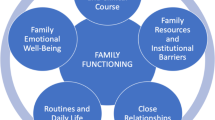Abstract
This paper studies a buried dynamic in psychopathology as it arises in family process: the child's loss of self through caring before being cared for. This role reversal which places childhood at the disposal of family need is conceptualized, and the related material, integrated, in terms of the myth of Cronus, who swallowed his children. Some tentative clinical probings of this subject are discussed as well as the resistive sources which have placed this subject, for the most part, beyond reach of research and education.
Similar content being viewed by others

References
Bell, N. and Vogel, E.A Modern Introduction to the Family. Glencoe: The Free Press of Glencoe, 1962.
Brown, N. (tr.)The Theogony of Hesiod. New York: Oxford University Press, 1970.
Cohen, S. The origin and function of sadistic behavior.Journal of Contemporary Psychotherapy, 1969,2, 1–9.
deMause, L. The evolution of childhood.The Journal of Psychohistory, 1974,1, 495–521.
Eliot, T.S.The Waste Land and Other Poems. New York: Harvest Books, 1962.
Emerson, R. Nature.The Journal of Psychohistory, 1973,1, 2–15.
Field, R.And Now Tomorrow. New York: The Macmillan Company, 1942.
Giffin, M., Johnson, A., Litin, E. Specific factors determining antisocial acting out.American Journal of Orthopsychiatry, 1954,24, 668–684.
Freud, S. in a letter to Joseph Wortis, quoted in Rheingold:The Fear of Being a Woman. New York: Grune and Stratton, 1964.
Gibran, K.The Prophet. New York: Alfred A. Knopf, 1967.
Joffroy, P.A Spy for God. New York: Harcourt Brace Jovanovich, 1971.
Jung, C. Psychological aspects of the mother archetype. InThe Collected Works, Vol. 9. New York: The Bollingen Series, 1953.
Kaufinan, I. The family constellation and overt incestuous relationships between father and daughter.American Journal of Orthopsychiatry, 1954,24, 266–277.
Kazantzakis, N.Report to Greco. New York: Simon and Schuster, 1965.
Lowen, A.Depression and the Body. New York: Coward, McGann and Geohegan, 1972.
Nelson, T. (Ed.)The Holy Bible. Revised standard version. New York: Thomas Nelson & Sons, 1952.
Porter, K.A.Ship of Fools. Boston: Little Brown and Company, 1962.
Rheingold, J.The Fear of Being a Woman. New York: Grune and Stratton, 1964.
Saint Exupery, A.The Little Prince. New York: Reynal & Hitchcock, 1943.
Slipp, S. The symbiotic survival pattern: A relational theory of schizophrenia.Family Process, 1973,12, 369–389.
Stierlin, H. Hitler as the bound delegate of his mother.The Journal of Psychohistory, 1976,3, 464–499.
Wright, W. (ed.)The Complete Works of William Shakespeare. New York: Garden City Publishing Company, 1936.
Rights and permissions
About this article
Cite this article
Crandall, J.W. The Cronus complex. Clin Soc Work J 12, 108–117 (1984). https://doi.org/10.1007/BF00755661
Issue Date:
DOI: https://doi.org/10.1007/BF00755661



